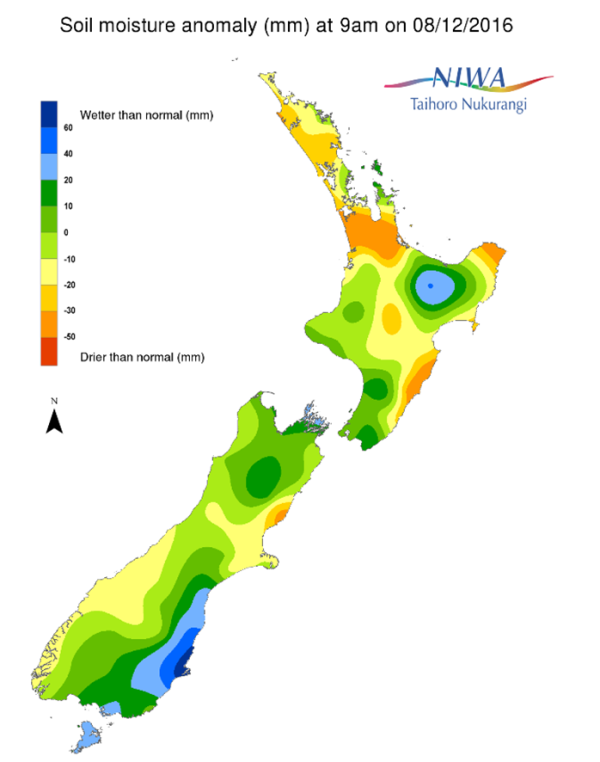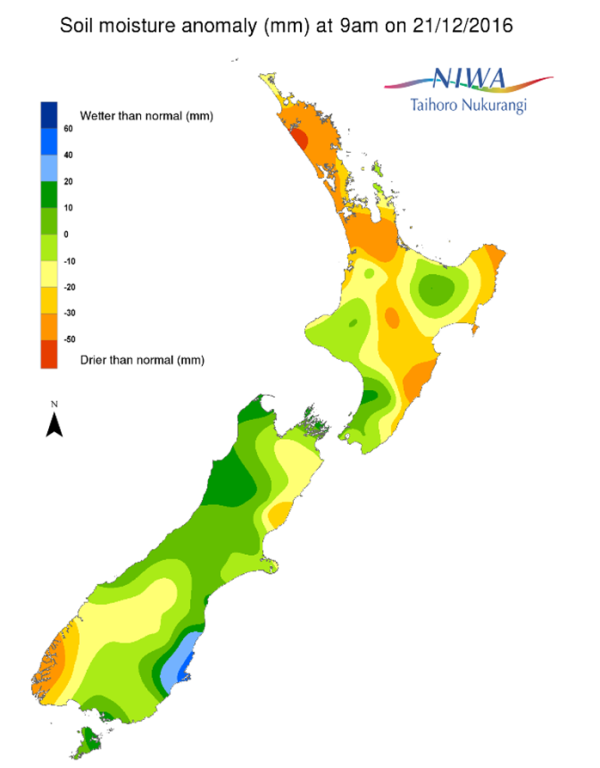An update describing soil moisture across the country to help assess whether severely to extremely dry conditions are occurring or imminent. Regions experiencing these soil moisture deficits are deemed “hotspots”. Persistent hotspot regions have the potential to develop into drought.
Facts: soil moisture
Over the past two weeks, rainfall has been lower than normal for much of the North Island, as a result most places saw a decrease in soil moisture levels. The exceptions were the regions of Taranaki and Manawatu-Whanganui where rainfall was near normal, resulting in largely unchanged soil moisture levels compared to 2 weeks prior. Soil moisture levels about Taranaki, Manawatu-Whanganui, Wellington and parts of the Bay of Plenty are near normal for the time of year with the remainder of the island seeing lower than normal soil moistures. The driest soils across the North Island compared to normal for this time of the year are found along the coast in the Central Hawke’s Bay and Tararua districts, East Cape, as well as northern Waikato and Northland. In the North Island, hotspots continue to stay in place in coastal areas of Central Hawke’s Bay and Tararua districts, East Cape, and in the Mahia Peninsula. Soils in parts of Auckland and Kaipara have now become extremely drier than normal and are being monitored for Hotspot development.
In the South Island, rainfall over the past 2 weeks has been above normal along the West Coast, western Tasman and Canterbury’s Selwyn and Waimakariri districts. Consequently, these areas saw a slight increase in soil moisture levels. The remainder of the island saw lower than normal rainfall during the past 2 weeks which has led to a slight decrease in soil moisture levels. Soil moisture levels continue to be wetter than normal in coastal Otago. The driest soils in the South Island compared to normal for this time of the year are still found in northern Canterbury where soils are severely drier than normal and a Hotspot persists.
Outlook and soil moisture
For the North Island, the only meaningful rainfall over the next week is expected to occur on Friday. Southern and western parts of the island will see the most rain with 10-25 mm expected throughout the day, however localised amounts up to 50 mm are possible.
The overall low rainfall outlook over the week ahead combined with high potential evapotranspiration rates, or the ability of the atmosphere to remove water from the surface, this time of the year means that soil moisture levels are expected to decrease and existing hotspot areas to expand for the North Island. The extremely drier than normal soil in parts of Auckland and Kaipara are expected to develop into a Hotspot.
For the South Island, a front will move up the West Coast throughout Wednesday and Thursday. The bulk of the rain will stay to the west of the ranges with 80-150+ mm expected over Fiordland. Beyond Thursday, a period of dry weather will ensue with another bout of heavy rain not expected until Tuesday-Wednesday next week when a front is set to move up the island.
The passage of two frontal rain bands over the next week should see soil moisture levels along the West Coast and western Tasman increase. As not much of this rain is expected to spill over to the east of the ranges, soil moisture levels for eastern parts of the South Island are expected to stay largely unchanged or slightly decrease. The hotspot in coastal Hurunui district will likely stay about the same or possibly increase is size.
The following soil moisture anomaly maps are relative to this time of the year and show soil anomaly for the past three weeks.
Background:
Hotspot Watch: a weekly advisory service for New Zealand media. It provides soil moisture and precipitation measurements around the country to help assess whether extremely dry conditions are imminent.
Soil moisture deficit: the amount of water needed to bring the soil moisture content back to field capacity, which is the maximum amount of water the soil can hold.
Soil moisture anomaly: the difference between the historical normal soil moisture deficit (or surplus) for a given time of year and actual soil moisture deficits.
Definitions: A “Hotspot” is defined as an area where extremely or severely dry soils have persisted for at least a week. “Extremely” and “severely” dry soils are based on a combination of the current soil moisture status and the difference from normal soil moisture. See soil moisture maps.


